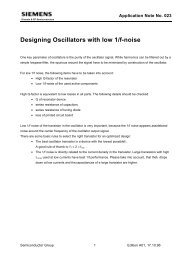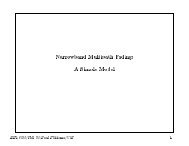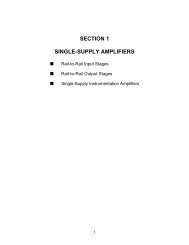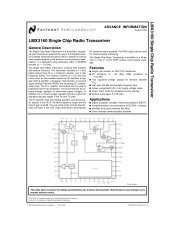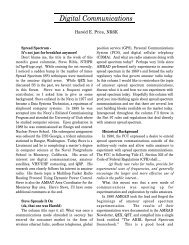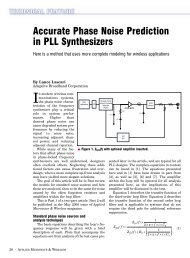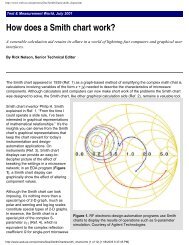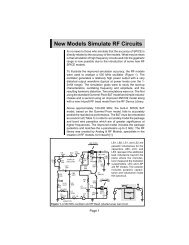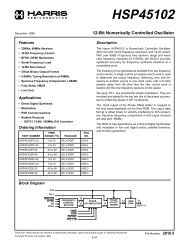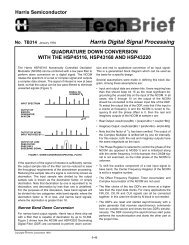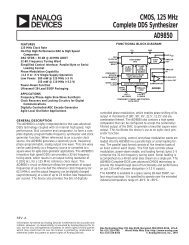Processing Gain for Direct Sequence Spread Spectrum ...
Processing Gain for Direct Sequence Spread Spectrum ...
Processing Gain for Direct Sequence Spread Spectrum ...
You also want an ePaper? Increase the reach of your titles
YUMPU automatically turns print PDFs into web optimized ePapers that Google loves.
PN Codes<br />
PN codes with the mathematical properties required <strong>for</strong><br />
implementation of a DSSS radio are:<br />
Maximum Length <strong>Sequence</strong>s<br />
Maximum length sequences (m-sequences), are PN<br />
sequences that repeat every 2 n -1, where n is an integer,<br />
they are implemented by shift registers and Exclusive Or<br />
gates, they are governed by primitive polynomials, and possess<br />
good randomness properties including a two-valued<br />
autocorrelation function [3].<br />
For example the 7 chip PN sequence is governed by the<br />
primitive polynomial generator<br />
c 7 (x) = 1 + x 2 + x 3<br />
and the output chips are given by:<br />
0 0 1 0 1 1 1 0 0 1 0 1 1 1 0 0 1 0 1 1 1 0 0 1 0 1 1 10...<br />
Application Note 9633<br />
Barker Codes<br />
Barker Codes are short unique codes that exhibit very good<br />
correlation properties. These short codes with N bits, with<br />
N=3 to 13, are very well suited <strong>for</strong> DSSS applications and<br />
can all be generated by the HSP3824. A list of Barker Codes<br />
is tabulated in Table 1.<br />
Willard Codes<br />
Willard Codes, found by computer simulation and optimization,<br />
and under certain conditions, offer better per<strong>for</strong>mance<br />
than Barker Codes. They can all be generated by the<br />
HSP3824, as was done <strong>for</strong> the Barker Codes. A list of<br />
Willard Codes is provided in Table 1.<br />
The inverted or bit reversed versions of the codes listed on<br />
Table 1 can be used since they still maintain the desired<br />
autocorrelation properties.<br />
-7T C -1/7<br />
with different spreading parameters <strong>for</strong> each direction.<br />
TABLE 1. BARKER AND WILLARD CODES<br />
BARKER<br />
WILLARD<br />
Figure 4 depicts the d(t), c(t) with the above m-sequence, N<br />
SEQUENCES<br />
SEQUENCES<br />
and with q(t) the x-or of d(t) and (ct).<br />
3 110 110<br />
1<br />
0<br />
4 1110 or 1101 1100<br />
5 11101 11010<br />
7 1110010 1110100<br />
d(t)<br />
T B<br />
t<br />
11 11100010010 11101101000<br />
13 1111100110101 1111100101000<br />
c(t)<br />
t<br />
T C<br />
7T C<br />
Configuring the HSP3824 to<br />
Implement Various PN Codes<br />
q(t)<br />
t The HSP3824 is the baseband processor of the PRISM<br />
chipset and it generates the PN sequence. The device is<br />
FIGURE 4. TIME DOMAIN SIGNALS WITH PG = 7 programmable to any desirable sequence of up to 16 bits.<br />
Figure 5 depicts the 7 chip sequence and its autocorrelation PN Generator Description<br />
function. Note that the autocorrelation also repeats every 7 The spread function <strong>for</strong> the radio is the same sequence and<br />
chips, or once per bit of the actual data if each of the data is applied to every symbol as BPSK modulation. PN generation<br />
is per<strong>for</strong>med by parallel loading the sequence from a<br />
bits is spread by the entire sequence.<br />
As another example, the 15 chip PN sequence is governed configuration register (CR) within the HSP3824 and serially<br />
by the primitive polynomial generator<br />
shifting it out to the modulator.<br />
c 15 (x) = 1 + x 3 + x 4<br />
PN Generator Programmable Registers<br />
A maximum of 16 bits can be programmed into the configuration<br />
register. Registers CR13 and CR14 contain the high<br />
and the output chips are given by:<br />
0 0 0 1 0 0 1 1 0 1 0 1 1 1 1 0 0 0 1 0 0 1 1 0 1 0 1 1 1 1 and low bytes of the sequence <strong>for</strong> the transmitter. The<br />
0 0 0 1 0 0 1 1 0 1 0 1 1 1 1...<br />
corresponding registers <strong>for</strong> the receiver are CR20 & CR21.<br />
Bits 5 & 6 of CR3 set the sequence length in chips per bit.<br />
c(t)<br />
The sequence is transmitted MSB first. When fewer than 16<br />
bits are in the sequence, the MSBs are truncated.<br />
1<br />
t<br />
0 T C<br />
PN Correlator Description<br />
-1<br />
The PN correlator is designed to handle BPSK spreading.<br />
R(t)<br />
Since the spreading is BPSK, the correlator is implemented<br />
1<br />
with two real correlators, one <strong>for</strong> the I and one <strong>for</strong> the Q<br />
channel. It has programmable registers to hold the<br />
spreading sequence and the sequence length <strong>for</strong> both the<br />
T C<br />
t receiver and the transmitter. This allows a full duplex link<br />
7T C<br />
FIGURE 5. SEVEN CHIP M-SEQUENCE AND ITS AUTOCOR-<br />
RELATION FUNCTION<br />
The correlators are time invariant matched filters otherwise<br />
known as parallel correlators.<br />
7-108



